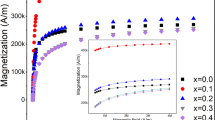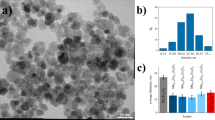Abstract
The skin effect imposes significant restrictions on the possible frequency and, consequently, the weight and size characteristics of resonant sources of electromagnetic (EM) field that are promising for use in the magnetic hyperthermia procedure. On the one hand, the heat release of magnetic nanoparticles (MNPs) increases linearly with an increase in the frequency of the EM field, which, on the other hand, simultaneously exacerbates the side effect of EM radiation on healthy tissues and ultimately leads to the need to solve a complex multi-parameter optimization problem of EM field parameters. This paper is devoted to a detailed study of the dependence of the thermal response of magnetic ZnxMn1–xFe2O4 nanoparticles on the frequency and amplitude of the EM field and to the determination of the optimal frequency range, from physical and from technical and physiological viewpoints, which can be most effectively used for magnetic hyperthermia. Nontoxic and biocompatible MNPs of ZnMn ferrites were obtained by chemical coprecipitation. The results of this study show that the MNP size and the Zn content significantly affect the Specific Absortpion Rate (SAR). MNPs of ZnMn ferrite with a zinc content of x = 0.15 and 0.2 have higher specific absorption rates (SARs) at low frequencies while MNPs with a high zinc content (x = 0.25 and 0.3) have significant SARs at higher frequencies. At the same time, the frequency dependence of the imaginary part of the magnetic susceptibility for MNPs of ZnMn ferrite found in this study demonstrates a maximum at 15 kHz. This indicates the significance of this frequency range, which is located significantly lower than that traditionally used in the practice of magnetic hyperthermia (100 kHz and higher), as well as the need to find the optimal combination of physical mechanisms of heat release in the range of 15–100 kHz with sufficient heat release and a minimum concentration of injected MNPs, which allow successful implementation of the magnetic hyperthermia procedure.








Similar content being viewed by others
REFERENCES
L. A. Brezovich, “Low frequency hyperthermia: Capacitive and ferromagnetic thermoseed methods,” Med. Phys. Monogr. 16, 11–82 (1988).
N. N. Liu, A. P. Pyatakov, A. M. Saletsky, M. N. Zharkov, N. A. Pyataev, G. B. Sukhorukov, Y. K. Gun’ko, and A. M. Tishin, “The “field or frequency” dilemma in magnetic hyperthermia: The case of Zn-Mn ferrite nanoparticles,” J. Magn. Magn. Mater. 555, 1–12 (2022). https://doi.org/10.1016/j.jmmm.2022.169379
N. N. Liu, A. P. Pyatakov, M. N. Zharkov, N. A. Pyataev, G. B. Sukhorukov, Y. A. Alekhina, N. S. Perov, Y. K. Gun’ko, and A. M. Tishin, “Optimization of Zn–Mn ferrite nanoparticles for low frequency hyperthermia: Exploiting the potential of superquadratic field dependence of magnetothermal response,” Appl. Phys. Lett. 120, 1–5 (2022). https://doi.org/10.1063/5.0082857
N. N. Liu, Yu. A. Alekhina, A. P. Pyatakov, M. N. Zharkov, N. A. Pyataev, N. S. Perov, G. B. Sukhorukov, and A. M. Tishin, “Interrelation of magnetic and magnetothermal properties of ZnMn ferrite nanoparticles,” Uchenye Zapiski Fizicheskogo Fakul’teta MGU, No. 4 (2022) (in press).
E. A. Périgo, G. Hemery, O. Sandre, D. Ortega, E. Garaio, F. Plazaola, and F. J. Teran, “Fundamentals and advances in magnetic hyperthermia,” Appl. Phys. Rev. 2 (4), 041302 (2015). https://doi.org/10.1063/1.4935688
R. R. Wildeboer, P. Southern, and Q. A. Pankhurst, “On the reliable measurement of specific absorption rates and intrinsic loss parameters in magnetic hyperthermia materials,” J. Phys. D: Appl. Phys. 47, 495003 (2014).https://doi.org/10.1088/0022-3727/47/49/495003
A. V. Nazarenko, Chastnoe Soobshchenie. Non-published (2018).
O. A. Kulikov, M. N. Zharkov, V. P. Ageev, D. E. Yakobson, V. I. Shlyapkina, A. V. Zaborovskiy, V. I. Inchina, L. A. Balykova, A. M. Tishin, G. B. Sukhorukov, and N. A. Pyataev, “Magnetic hyperthermia nanoarchitectonics via iron oxide nanoparticles stabilised by oleic acid: Anti-tumour efficiency and safety evaluation in animals with transplanted carcinoma,” Int. J. Mol. Sci. 23, 4234 (2022). https://doi.org/10.3390/ijms23084234
D. Soukup, S. Moise, E. Céspedes, J. Dobson, and N. D. Telling, “In situ measurement of magnetization relaxation of internalized nanoparticles in live cells,” ACS Nano 9 (1), 231–240 (2015). https://doi.org/10.1021/nn503888j
ACKNOWLEDGMENTS
We thank Profs. Yu.K. Gunko and N.S. Perov for useful discussions of the materials of this study.
Funding
This work was supported by the Russian Foundation for Basic Research, grant no. 19-29-10013 N.N. Liu. is grateful to the Chinese Scholarship Council for supporting her studies.
Author information
Authors and Affiliations
Corresponding author
Additional information
Translated by A. Ivanov
Rights and permissions
About this article
Cite this article
Liu, N.N., Pyatakov, A.P., Zharkov, M.N. et al. The Dependence of the Magnetothermal Properties of ZnxMn1 – xFe2O4 Nanoparticles on the Magnetic Field Near Physiological Brezovich Limit. Phys. Metals Metallogr. 123, 954–962 (2022). https://doi.org/10.1134/S0031918X22600919
Received:
Revised:
Accepted:
Published:
Issue Date:
DOI: https://doi.org/10.1134/S0031918X22600919




